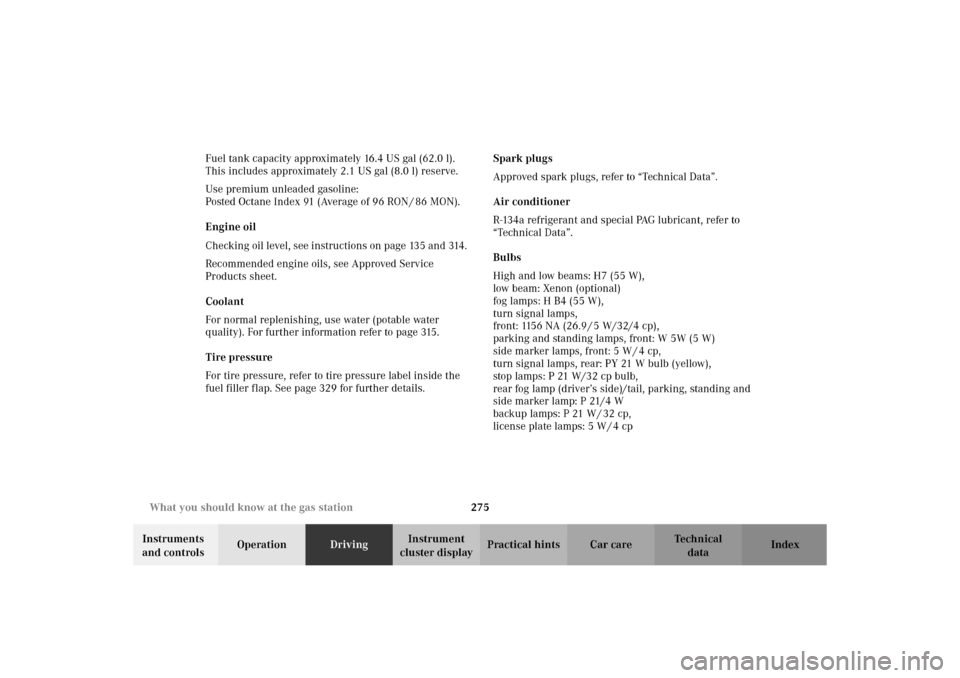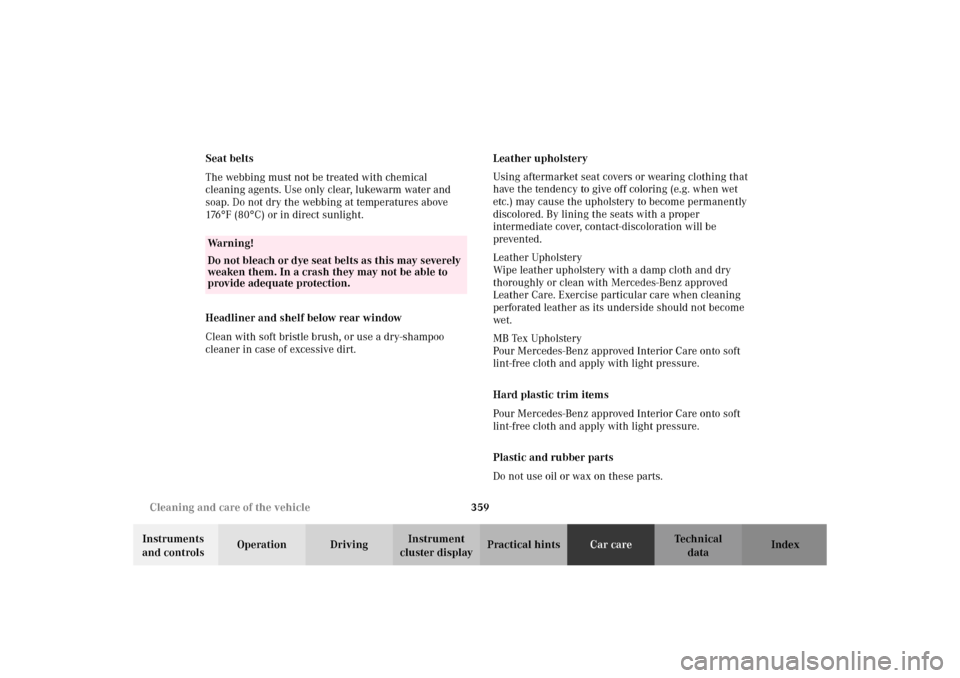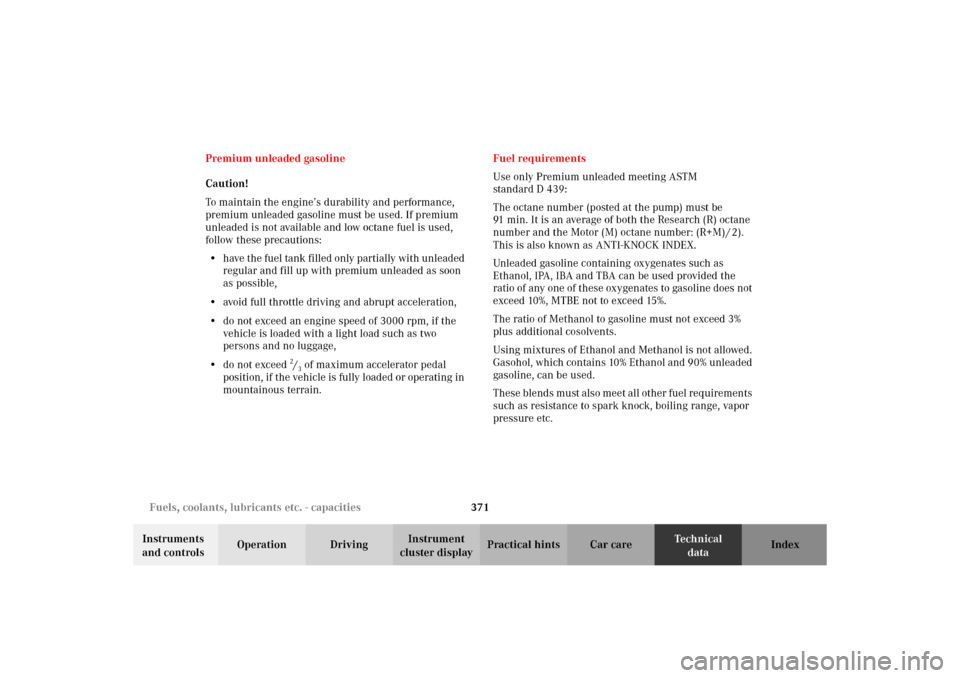2002 MERCEDES-BENZ C320 WAGON oil pressure
[x] Cancel search: oil pressurePage 8 of 390

5 ContentsELEC. STABIL. PROG.
(Electronic stability program) ..292
COOLANT
(coolant level) .............................293
COOLANT
(coolant temperature) ................294
ENGINE OIL LEVEL ...................295
STEERING GEAR OIL .................296
LIGHTING SYSTEM ....................297
LAMP SENSOR ...........................299
DOOR ............................................299
TRUNK OPEN .............................300
HOOD ...........................................300
TELEPHONE – FUNCTION ....... 301
TELE AID ..................................... 301
WASHER FLUID ..........................302
RESTRAINT SYSTEM .................303
KEY ...............................................303
FUEL RESERVE ..........................304
UNDERVOLTAGE ........................304
Practical hintsFirst aid kit ..................................... 306
Stowing things in the vehicle ...... 307
Fuses ............................................... 307
Hood ................................................. 311
Adding engine oil ........................... 314
Automatic transmission
fluid level .................................... 315
Coolant level .................................... 315
Adding coolant ............................ 316
Windshield and headlamp
washer system ........................... 316
Spare wheel,
storage compartment ................ 318
Vehicle tools .................................... 319
Vehicle jack .................................... 320
Wheels ............................................ 321
Tire replacement ....................... 321
Rotating wheels ......................... 322Spare wheel ....................................323
Spare wheel bolts .......................323
Changing wheels ...........................324
Tire inflation pressure ..................329
Battery .............................................330
Jump starting ..................................332
Towing the vehicle .........................335
Transmission selector lever,
manually unlocking ...................338
Exterior lamps ................................339
Replacing bulbs ..........................339
Standby bulb function ...................345
Changing batteries in the
electronic main key ..................346
Synchronizing
remote control ............................348
Emergency engine shut-down .....348
Fuel filler flap, manual release ...349
Replacing wiper blade insert ....... 351
Roof rack .........................................352
S203.book Seite 5 Freitag, 19. Oktober 2001 1:25 13
Page 278 of 390

275 What you should know at the gas station
Te ch n i c a l
data Instruments
and controlsOperationDrivingInstrument
cluster displayPractical hints Car care Index Fuel tank capacity approximately 16.4 US gal (62.0 l).
This includes approximately 2.1 US gal (8.0 l) reserve.
Use premium unleaded gasoline:
Posted Octane Index 91 (Average of 96 RON / 86 MON).
Engine oil
Checking oil level, see instructions on page 135 and 314.
Recommended engine oils, see Approved Service
Products sheet.
Coolant
For normal replenishing, use water (potable water
quality). For further information refer to page 315.
Tire pressure
For tire pressure, refer to tire pressure label inside the
fuel filler flap. See page 329 for further details.Spark plugs
Approved spark plugs, refer to “Technical Data”.
Air conditioner
R-134a refrigerant and special PAG lubricant, refer to
“Technical Data”.
Bulbs
High and low beams: H7 (55 W),
low beam: Xenon (optional)
fog lamps: H B4 (55 W),
turn signal lamps,
front: 1156 NA (26.9 / 5 W/32/4 cp),
parking and standing lamps, front: W 5W (5 W)
side marker lamps, front: 5 W / 4 cp,
turn signal lamps, rear: PY 21 W bulb (yellow),
stop lamps: P 21 W/32 cp bulb,
rear fog lamp (driver’s side)/tail, parking, standing and
side marker lamp: P 21/4 W
backup lamps: P 21 W / 32 cp,
license plate lamps: 5 W / 4 cp
S203.book Seite 275 Freitag, 19. Oktober 2001 1:25 13
Page 308 of 390

305 Contents - Practical hints
Te ch n i c a l
data Instruments
and controlsOperation DrivingInstrument
cluster displayPractical hintsCar care Index
Practical hintsFirst aid kit .....................................306
Stowing things in the vehicle ......307
Fuses ................................................307
Hood ................................................. 311
Adding engine oil .......................... 314
Automatic transmission
fluid level ................................... 315
Coolant level ................................... 315
Adding coolant ........................... 316
Windshield and headlamp
washer system ........................... 316Spare wheel,
storage compartment ................ 318
Vehicle tools .................................... 319
Vehicle jack .................................... 320
Wheels ............................................ 321
Tire replacement ....................... 321
Rotating wheels ......................... 322
Spare wheel .................................... 323
Spare wheel bolts ...................... 323
Changing wheels ........................... 324
Tire inflation pressure ................. 329
Battery ............................................. 330
Jump starting ................................. 332Towing the vehicle .........................335
Transmission selector lever,
manually unlocking ...................338
Exterior lamps ................................339
Replacing bulbs ..........................339
Standby bulb function ...................345
Changing batteries in the
electronic main key ..................346
Synchronizing
remote control ............................348
Emergency engine shut-down .....348
Fuel filler flap, manual release ...349
Replacing wiper blade insert ....... 351
Roof rack .........................................352
S203.book Seite 305 Freitag, 19. Oktober 2001 1:25 13
Page 362 of 390

359 Cleaning and care of the vehicle
Te ch n i c a l
data Instruments
and controlsOperation DrivingInstrument
cluster displayPractical hintsCar careIndex Seat belts
The webbing must not be treated with chemical
cleaning agents. Use only clear, lukewarm water and
soap. Do not dry the webbing at temperatures above
176
°F (80
°C) or in direct sunlight.
Headliner and shelf below rear window
Clean with soft bristle brush, or use a dry-shampoo
cleaner in case of excessive dirt.Leather upholstery
Using aftermarket seat covers or wearing clothing that
have the tendency to give off coloring (e.g. when wet
etc.) may cause the upholstery to become permanently
discolored. By lining the seats with a proper
intermediate cover, contact-discoloration will be
prevented.
Leather Upholstery
Wipe leather upholstery with a damp cloth and dry
thoroughly or clean with Mercedes-Benz approved
Leather Care. Exercise particular care when cleaning
perforated leather as its underside should not become
wet.
MB Tex Upholstery
Pour Mercedes-Benz approved Interior Care onto soft
lint-free cloth and apply with light pressure.
Hard plastic trim items
Pour Mercedes-Benz approved Interior Care onto soft
lint-free cloth and apply with light pressure.
Plastic and rubber parts
Do not use oil or wax on these parts.
Wa r n i n g !
Do not bleach or dye seat belts as this may severely
weaken them. In a crash they may not be able to
provide adequate protection.
S203.book Seite 359 Freitag, 19. Oktober 2001 1:25 13
Page 374 of 390

371 Fuels, coolants, lubricants etc. - capacities
Te ch n i c a l
data Instruments
and controlsOperation DrivingInstrument
cluster displayPractical hints Car care Index Premium unleaded gasoline
Caution!
To maintain the engine’s durability and performance,
premium unleaded gasoline must be used. If premium
unleaded is not available and low octane fuel is used,
follow these precautions:
•have the fuel tank filled only partially with unleaded
regular and fill up with premium unleaded as soon
as possible,
•avoid full throttle driving and abrupt acceleration,
•do not exceed an engine speed of 3000 rpm, if the
vehicle is loaded with a light load such as two
persons and no luggage,
•do not exceed
2/3 of maximum accelerator pedal
position, if the vehicle is fully loaded or operating in
mountainous terrain.Fuel requirements
Use only Premium unleaded meeting ASTM
standard D 439:
The octane number (posted at the pump) must be
91 min. It is an average of both the Research (R) octane
number and the Motor (M) octane number: (R+M) / 2).
This is also known as ANTI-KNOCK INDEX.
Unleaded gasoline containing oxygenates such as
Ethanol, IPA, IBA and TBA can be used provided the
ratio of any one of these oxygenates to gasoline does not
exceed 10%, MTBE not to exceed 15%.
The ratio of Methanol to gasoline must not exceed 3%
plus additional cosolvents.
Using mixtures of Ethanol and Methanol is not allowed.
Gasohol, which contains 10% Ethanol and 90% unleaded
gasoline, can be used.
These blends must also meet all other fuel requirements
such as resistance to spark knock, boiling range, vapor
pressure etc.
S203.book Seite 371 Freitag, 19. Oktober 2001 1:25 13
Page 384 of 390

381 Index
Te ch n i c a l
data Instruments
and controlsOperation DrivingInstrument
cluster displayPractical hints Car careIndex Multifunction display ...................................................... 96
Coolant temperature ................................................. 100
Engine oil level indicator ......................................... 100
FSS .............................................................................. 100
Individual settings .....................................................115
Tire inflation pressure monitor .............................. 100
Trip and main odometer .......................................... 100
Vehicle speed ............................................................. 100
Multifunction steering wheel ........................................ 96
NNavigation system ...........................................................110
Night security illumination ......................................... 140OOn-board diagnostic system .........................................278
Opening the tailgate ........................................................ 40
Overhead control panel ................................................... 21
PPanic button ......................................................................35
Parcel net in front passenger footwell ....................... 203
Parcel net in trunk ........................................................ 208
Parking brake ................................................................ 252
Power windows ............................................................... 185
Blocking of rear door window operation ............... 187
Express opening and closing .................................. 186
Opening and closing ...................................................34
Synchronizing power windows ............................... 187
Problems with your vehicle ............................................ 14
Product information .......................................................... 7RRadio
See Radio mode ......................................................... 167
Rain sensor ..................................................................... 143
Rear passenger compartment
adjustable air outlets ................................................ 160
Rear window defroster .................................................. 158
Rear window wiper/washer ......................................... 146
Removal and installation
of front seat head restraints ......................................50
S203.book Seite 381 Freitag, 19. Oktober 2001 1:25 13